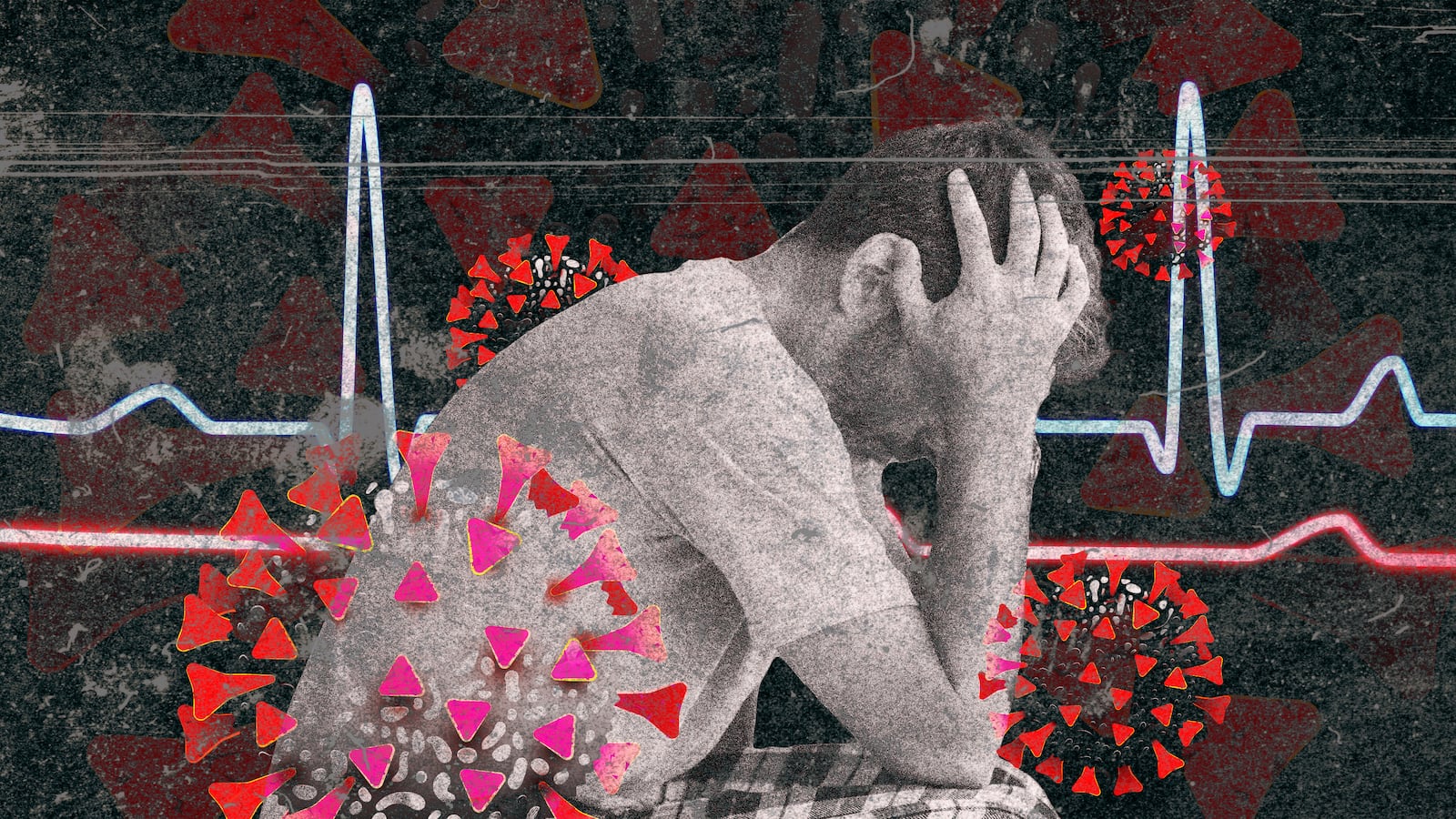A mild case of COVID for many people resembles a cold, a comforting illusion that President Joe Biden’s recent bout with the virus reinforced even when another positive test returned him to quarantine. And yet, for all the happy talk, the virus continues to remind us that it can wreak havoc on relatively young, healthy people.
This is the story of a 49-year-old former Navy SEAL—still in top shape—who tested positive for COVID on the second day of a family trip to Alaska. He learned the hard way that his superior physicality was no match for the coronavirus.
We’ll call him Sam, as he doesn’t want his name used in order to be candid about the brain effects he still is experiencing that could remain as “long COVID,” and to protect his health record and that of his family “from being dinged for a pre-existing medical condition,” as Sam put it to The Daily Beast.
Sam had joined his wife and 12-year-old daughter a week into the vacation because of work commitments. “As a former Navy SEAL raising a daughter to be tough outdoors,” he had planned time north of the Arctic circle to hike Katmai and Denali national parks to see the grizzlies catching live salmon that had just started running upstream the week before.
They were traveling with his 80-year-old father-in-law, and to protect him, the family tested for COVID morning and evening. “My daughter went down first,” Sam said. It was the morning of his second day in Alaska, and they were far north of civilization.
“We could see our daughter’s lethargy increasing as she slid downhill,” Sam noted. They chartered a small private plane back to Fairbanks where they spent six hours in a hospital emergency room getting their daughter hydrated with IV fluids. Her throat was so sore she couldn’t eat or drink.

A silhouette of a patient is treated in the COVID-19 intensive care unit at University Hospital Leipzig in Leipzig, Germany.
Jens Schlueter/GettyThat night, Sam and his wife tested themselves. She was negative, but there was a faint line on his test, concerning enough that they slept with their N95 masks on. By morning, there was no doubt. Sam was strongly positive and showing symptoms. Now two of them were down. What if his wife also got sick?
They had trouble booking enough rooms to quarantine, and rather than bounce between hotels in the crowded tourist town, they decided to drive seven and a half hours from Fairbanks to Anchorage in search of more accessible health care. They rented a car which his wife drove 70mph with the windows and sunroof open, with his daughter slumped against her seat belt in the back seat using a “Type to Speak” app because of her sore throat. They were all masked.
The cost of an already expensive trip had become astronomical. They had already paid for the remote cabin in Denali. In Anchorage, it came to nearly a thousand dollars per day to find last-minute hotel rooms in which to isolate the uninfected (his wife) from those at stages of infection several days apart from each other, in hopes to get their daughter healthy enough to make it to a previously-scheduled summer camp.
In Anchorage, Sam searched by phone to find monoclonal antibodies and quickly discovered that among the limited supplies Alaska had left, there was none that addressed Omicron and its variants. Finding a pharmacy that would give him Paxlovid without a prescription seemed futile, so he called the Veterans Administration (VA) and was told he could get health care at Elmendorf Air Force Base, once they signed him into the system as a veteran no longer on active duty.
“Kudos to the VA—love the VA,” Sam said. Arriving at the base hospital, he encountered a sign that said, “Do not come in if you’re COVID positive.” It took a half-hour to admit him to a back entrance, but once inside it was a short wait until a doctor saw him. By then, Sam’s temperature was 102 and his blood oxygen levels were drifting from the low 90s to 88 and 89. He is normally at 98. Below 95 is concerning.
The doctor prescribed Paxlovid, which to be effective must be started within five days of first showing symptoms. Sam was on day three. The medication is known for leaving a metallic after-taste. “I felt like I was sucking on an aluminum bar,” he says, a tolerable discomfort considering the alternative. “By day eight, I was definitely feeling better, but still feeling fatigue and severe brain fog.”
The family stayed in quarantine at the hotel in Anchorage, leaving the “Do Not Disturb” sign on the door and venturing out only when necessary and always masked. They passed the time watching Marvel Universe movies while Sam, a self-described “prodigious researcher,” read medical journals to inform himself about this virus that he felt was messing with his brain.
It was how he coped, Sam said, learning everything he could about the science of this virus that had upended his life. A few blocks away, former President Donald Trump was holding a “Save America” rally and the hotel was full of unmasked rally-goers unaware of the active COVID in their midst. “We tried not to give it to them in the elevator as we went to pick up food deliveries, wearing our N95s,” Sam added.
He started testing negative on day 10, but did not feel fully recovered. Sam emailed his mother and brother to say, “Take it from me, you cannot assume our genetics will let you glide through COVID.”

A long COVID patient does breathing training in a gymnastics room at the Teutoburger Wald Clinic, a rehab clinic for post-COVID sufferers.
Friso Gentsch/Picture Alliance via GettyDriving home the point, Sam said, “A cold doesn’t give you brain inflammation.”
“I was not realistically thinking I was going to die, because I have received three shots of the vaccine,” Sam added. “But I was, as the brain fog did not recede with the other symptoms, petrified. What if it lasts a long time? Or [become] permanent, as I have read about many Americans for whom it has not fully gone away?”
Brain lethargy is not just being tired, Sam said. It’s like being burned out from the beginning of the day on top of being tired. For someone accustomed to driving himself, he said on day 20: “You don’t know what it’s like to lose your ambition overnight. I used to greet the day enthusiastically, now I think about how nice it would be to stay in bed all day and read.”
Some days later, Sam reported intending to get back to “my normal ambitious self,” but it didn’t work. “I struggle not to feel I am weaker because it hit me harder than others.”
Sam has concluded that his immune system, seven and a half months after his third dose of the COVID vaccine, “viewed the little bastard intruders as no big deal, until it was a big deal and they had gotten in my lungs, and then it decided to kick into overdrive.”
“I am not 100 percent yet,” he told The Daily Beast on day 26, noting his prior workweek attempt was disastrous. “Part of me wants to say I’m better and that will become a self-fulfilling prophecy, and part of me is telling the truth because I might need help.” The changes he describes like a brief memory lapse or difficulty staying focused resemble normal signs of aging, but unlike the slow process of aging, these are sudden changes, “like aging 20 years in less than a month.”
Sam’s father-in-law, at age 80-plus, flew home from Alaska earlier and did not get the virus. His wife never got it either. They’d each received a second booster four weeks before the trip. Sam’s daughter recovered quickly enough to attend camp, though it took 10 days.
This story is a fair demonstration of how difficult and expensive it can be to find accommodations for quarantining, to protect the uninfected in one’s family as well as the public at large. And it also shows how, in the third year of the pandemic, obtaining the necessary treatments for a severe case of COVID requires quality health-care coverage, the determination to seek out proper care, and the means to procure the medication—which can frequently be in low supply, particularly in remote areas.
These are societal “COVID problems” that are frequently glossed over, and which need to be prioritized by governments, especially if they’re determined to “move on.”
Living with the virus requires a healthy respect for its ability to evolve together with an understanding of our limitations as humans to ward off its worst effects. One former Navy SEAL’s story is a cautionary tale that we are in the third year of a pandemic, and COVID still packs a wallop.








